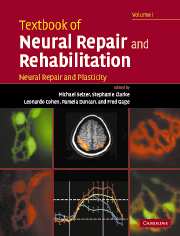Book contents
- Frontmatter
- Contents
- Contents (contents of Volume II)
- Preface
- Contributors (contributors of Volume I)
- Contributors (contributors of Volume II)
- Neural repair and rehabilitation: an introduction
- Section A Neural plasticity
- Section A1 Cellular and molecular mechanisms of neural plasticity
- Section A2 Functional plasticity in CNS system
- Section A3 Plasticity after injury to the CNS
- Section B1 Neural repair
- Section B2 Determinants of regeneration in the injured nervous system
- Section B3 Promotion of regeneration in the injured nervous system
- Section B4 Translational research: application to human neural injury
- 31 Alzheimer's disease, model systems and experimental therapeutics
- 32 Biomimetic design of neural prostheses
- 33 Brain–computer interfaces for communication and control
- 34 Status of neural repair clinical trials in brain diseases
- Index
33 - Brain–computer interfaces for communication and control
from Section B4 - Translational research: application to human neural injury
Published online by Cambridge University Press: 05 March 2012
- Frontmatter
- Contents
- Contents (contents of Volume II)
- Preface
- Contributors (contributors of Volume I)
- Contributors (contributors of Volume II)
- Neural repair and rehabilitation: an introduction
- Section A Neural plasticity
- Section A1 Cellular and molecular mechanisms of neural plasticity
- Section A2 Functional plasticity in CNS system
- Section A3 Plasticity after injury to the CNS
- Section B1 Neural repair
- Section B2 Determinants of regeneration in the injured nervous system
- Section B3 Promotion of regeneration in the injured nervous system
- Section B4 Translational research: application to human neural injury
- 31 Alzheimer's disease, model systems and experimental therapeutics
- 32 Biomimetic design of neural prostheses
- 33 Brain–computer interfaces for communication and control
- 34 Status of neural repair clinical trials in brain diseases
- Index
Summary
Introduction
Early speculation
Electrical signals produced by brain activity were first recorded from the cortical surface in animals by Richard Caton in 1875 (Caton, 1875) and from the human scalp by Hans Berger in 1929 (Berger, 1929). In the 75 years since Berger's first report, electroencephalographic (EEG) activity has been used mainly for clinical diagnosis and for exploring brain function. Nevertheless, throughout this period, scientists and others have speculated that the EEG or other measures of brain activity might serve an entirely different purpose, that they might provide the brain with another means of conveying messages and commands to the external world. While normal communication and control necessarily depend on peripheral nerves and muscles, brain signals such as the EEG suggested the possibility of non-muscular communication and control, achieved through a brain–computer interface (BCI).
Recent interest and activity
Despite long interest in this possibility, and despite isolated demonstrations (e.g., Vidal, 1973; 1977) it has only been in the past two decades that sustained research has begun, and only in the past 10 years that a recognizable field of BCI research, populated by a rapidly growing number of research groups, has developed (see Wolpaw et al. (2002) for review). This recent interest and activity reflect the confluence of four factors.
The first factor is the greatly increased appreciation of both the needs and the abilities of people severely affected by motor disorders such as cerebral palsy, spinal cord injury, brain stem stroke, amyotrophic lateral sclerosis (ALS), and muscular dystrophies.
Keywords
- Type
- Chapter
- Information
- Textbook of Neural Repair and Rehabilitation , pp. 602 - 614Publisher: Cambridge University PressPrint publication year: 2006
- 30
- Cited by



